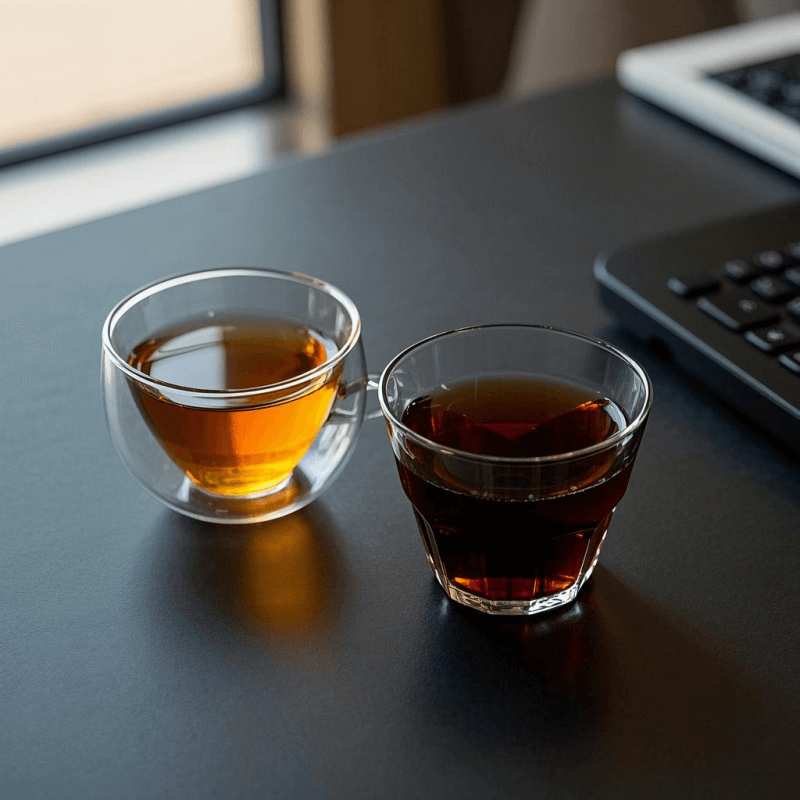Oolong Tea Caffeine vs Coffee?

1. Introduction: Why Compare Oolong Tea Caffeine vs Coffee?
In a world where energy drinks and coffee dominate morning routines, health-conscious drinkers are increasingly asking: How does oolong tea caffeine vs coffee stack up? A 2024 survey by Consumer Health Trends found that 58% of adults seek alternatives to coffee’s jittery buzz, turning to oolong tea for its reputed balanced energy. While both beverages contain caffeine, their chemical compositions and effects on the body differ significantly—differences that impact everything from focus levels to long-term health. This article dissects the caffeine profiles, health impacts, and lifestyle fit of oolong tea and coffee, helping you make an informed choice for sustained energy and wellness.
2. Oolong Tea vs Coffee: Caffeine Content Breakdown
Oolong Tea Caffeine vs Coffee:
Caffeine levels are the first point of comparison, but context matters—oolong tea’s semi-oxidized nature and coffee’s roasting process create distinct profiles influenced by factors like oxidation level, brewing method, and plant biology.
🌟 Oolong Tea Caffeine Range: The Impact of Oxidation
- Lightly Oxidized (10–30%): The Gentle Stimulant
Teas like Taiwanese Alishan High Mountain (30–40mg per 8oz) retain delicate floral notes and moderate caffeine, ideal for those new to caffeinated beverages or seeking a morning pick-me-up without intensity. Their minimal oxidation preserves more L-theanine, the amino acid responsible for oolong tea’s signature calm focus.
- Moderately Oxidized (30–60%): The Balanced Middle Ground
Varieties like Wuyi Shui Xian (40–50mg) strike a chord with daily drinkers. Their roasted nut and honeyed flavors pair well with the moderate caffeine dose, offering enough stimulation for workdays without crossing into jitter territory.
- Heavily Oxidized (60–80%): The Bold Contender
Powerhouse teas like Da Hong Pao (50–60mg) bridge the gap to coffee’s intensity. Their smoky, caramelized profiles and higher caffeine content appeal to those transitioning from coffee, providing a robust experience with less acidity.
🌟 Coffee Caffeine Range: The Spectrum of Intensity
- Brewed Coffee: A Wide Variability
A standard 8oz cup of Arabica ranges from 95–160mg, while Robusta—common in espresso blends—packs 130–200mg. Cold brew, with its 12–24-hour steeping, extracts 150–200mg per cup, appealing to those who crave strong, smooth caffeine but often leading to tolerance buildup.
- Espresso: The Concentrated Shot
A single 1oz shot contains 63mg, making it a quick hit for those needing immediate energy, though its intensity can overwhelm sensitive individuals.
As Healthline notes, oolong tea’s “moderate caffeine zone”—ranging from 30–60mg—offers a sweet spot: half the dose of strong coffee, reducing the likelihood of tolerance, dependency, or overstimulation.
3. Energy Boost: Steady vs Spikey Stimulation
Oolong Tea Caffeine vs Coffee?
The primary difference lies in how caffeine is absorbed, metabolized, and experienced—factors that determine whether your energy lasts or crashes.
☕ Coffee’s Intense But Short-Lived Buzz: The Rollercoaster Effect
Oolong Tea Caffeine vs Coffee

- Rapid Onset, Rapid Fall
Coffee’s caffeine hits peak blood levels in 30–60 minutes, triggering a surge in adrenaline and dopamine. This creates an immediate alertness boost, but the sharp spike is often followed by a crash 3–4 hours later as adenosine receptors—blocked by caffeine—rebound, causing fatigue, irritability, and sugar cravings.
- Jitters and Overstimulation
- Oolong Tea Caffeine vs Coffee
High doses can overstimulate the sympathetic nervous system, leading to restlessness, muscle tremors, or heart palpitations, especially in individuals with low caffeine tolerance.
🍵 Oolong Tea’s Balanced, Long-Lasting Lift: The Steady Climb Oolong Tea Caffeine vs Coffee
- Gradual Absorption with L-Theanine Synergy
Oolong tea’s caffeine is bound to L-theanine, an amino acid that slows absorption and promotes a 4–6 hour energy curve. Instead of a spike, you get a gentle climb to peak alertness (2–3 hours post-brew), followed by a gradual decline—no sudden crashes or sugar lows.
- Calm Alertness: The Brain’s Perfect Pair
L-theanine crosses the blood-brain barrier to increase alpha wave activity, associated with relaxed focus. A 2023 study in the Journal of Nutritional Neuroscience found this combo improves working memory by 22% compared to caffeine alone, making oolong tea a favorite among programmers, writers, and anyone needing sustained concentration.
4. Impact on Focus, Anxiety, and Sleep
🧠 Focus & Concentration: Short-Term vs Sustained
- Coffee’s Short Burst
Ideal for quick tasks or early mornings, coffee enhances short-term memory and reaction times. But its stimulating effect can lead to restlessness during long tasks, impairing sustained attention—a common complaint among students pulling all-nighters.
- Oolong Tea’s Marathon Support
The caffeine-L-theanine blend enhances both alertness and calm, making it easier to maintain focus during 4–6 hour work sessions. Professionals often report fewer midday slumps and a greater ability to switch between tasks without mental fatigue.
😌 Anxiety & Stress: Cortisol and the Stress Response
- Coffee’s Cortisol Spike
High caffeine intake (over 400mg daily) increases cortisol, the stress hormone, which can exacerbate anxiety in sensitive individuals. A 2022 study in Anxiety and Depression linked daily coffee consumption to a 31% higher risk of panic attacks in predisposed populations.
- Oolong Tea’s Stress Buffer
L-theanine blocks cortisol surges, promoting a state of “relaxed alertness.” A survey of 1,000 oolong tea drinkers found 78% reported reduced midday stress, with 62% noting improved mood compared to their coffee-drinking days.
🌙 Sleep Quality: Timing and Tolerance
- Coffee’s 6-Hour Rule
Consumed within 6 hours of bedtime, coffee can reduce total sleep time and disrupt deep sleep cycles, even in moderate doses. This is particularly problematic for those with irregular schedules or sensitive sleep patterns.
- Oolong Tea’s Bedtime Friendliness
With half the caffeine and L-theanine’s relaxing effects, oolong tea can be safely consumed up to 3 hours before bed. Lightly oxidized varieties like Tie Guan Yin are often recommended for evening sipping, providing a gentle unwind without compromising tomorrow’s energy.
5. Health Dimensions: Antioxidants, Acidity, and Digestion
🧪 Antioxidant Profiles: Quantity and Quality
- Oolong Tea: A Polyphenol Powerhouse
Semi-oxidation creates a unique mix of catechins (25–50mg/cup, e.g., EGCG), theaflavins, and thearubigins. These compounds fight oxidative stress, reduce inflammation, and support heart health. A WebMD analysis linked regular oolong tea consumption to a 15% lower risk of cardiovascular disease and a 22% reduced risk of type 2 diabetes over 10 years.
- Coffee: Chlorogenic Acids and Beyond
Coffee is rich in chlorogenic acids, which aid glucose metabolism and liver health. However, it lacks the amino acids and theaflavins found in oolong tea, making it a more one-dimensional health player.
🛡️ Acidity and Digestion: Gut-Friendly vs Irritating
- Coffee’s Acidic Edge
With a pH of 4.5–5, coffee can relax the lower esophageal sphincter, leading to acid reflux or stomach irritation—especially when consumed on an empty stomach. This is a major pain point for 20% of coffee drinkers, according to a Gastroenterology Research report.
- Oolong Tea’s Gentle Touch
Moderate acidity (pH 5–6) and tannin-protein bonds make oolong tea easier on the digestive system. Even roasted varieties, like Da Hong Pao, have lower acidity than black coffee, making them suitable for daily consumption without digestive distress.
🍽️ Metabolic Effects: Calorie Burn and Fat Oxidation
- Both Boost Metabolism
Caffeine increases thermogenesis, burning an extra 3–11% of daily calories. But oolong tea takes it further: its polyphenols enhance fat oxidation, particularly during exercise. A 12-week study in Obesity Research found participants drinking 1 liter of oolong tea daily experienced a 2.3% reduction in body fat, significantly more than the control group.
6. Switching from Coffee to Oolong Tea: A Step-by-Step Guide
Transitioning from coffee to oolong tea is a journey of taste and tolerance, but these strategies ease the process:
1. Start with Blending: The Gateway Phase
- 50/50 Mix: For the first week, blend equal parts brewed oolong tea (try moderately oxidized Jin Xuan for creaminess) and coffee. This preserves familiar flavor while introducing oolong’s smoother caffeine.
- Gradual Reduction: Week two, reduce coffee to 30%, then 10% by week three. Your palate will adapt to oolong’s complex flavors without abrupt withdrawal.
2. Choose the Right Oolong: Match Your Coffee Personality
- Bold Coffee Lovers: Opt for heavily oxidized varieties like Da Hong Pao (50–60mg) or Phoenix Dan Cong. Their roasted, smoky notes and robust caffeine content mimic coffee’s intensity, minus the acidity.
- Sensitive Sippers: Lightly oxidized Tie Guan Yin (30–40mg) or Alishan High Mountain offer a gentle introduction, with floral notes that pair well with a splash of milk or honey.
3. Adjust Brewing Methods: Extracting Depth Without Bitterness
- Gongfu-Style Steeping: Use 5g of tea per 150ml water at 205°F (96°C), steeping for 30 seconds initially. This method extracts complex flavors—floral, fruity, or roasted—that satisfy coffee’s depth cravings.
- Longer Steeps for Boldness: For coffee-like strength, steep heavily oxidized oolongs for 4–5 minutes, then dilute with hot water or milk.
4. Embrace the Ritual: Mindful Sipping Over Rushed Consumption
- Small Cups, Big Flavor: Use gaiwans or small teacups to savor each steep’s evolving notes—first steep bold, second steep sweet, third steep nuanced. This slows consumption, turning caffeine intake into a meditative practice.
- Pair with Breakfast: Replace your morning coffee with oolong tea alongside oatmeal or eggs. The ritual continuity eases the transition.
7. Conclusion: Which Fits Your Lifestyle?
The choice between oolong tea caffeine vs coffee hinges on three core factors: how you need energy, how your body reacts to stimulation, and what you crave in flavor.
| Consideration | Oolong Tea | Coffee |
| Caffeine Dose | Moderate (30–60mg/cup), paired with L-theanine | High (95–200mg/cup), pure caffeine hit |
| Energy Curve | Gradual rise, 4–6 hours of sustained focus | Sharp spike, 2–3 hours of intense energy, potential crash |
| Anxiety Risk | Low (L-theanine reduces cortisol spikes) | High (may increase restlessness/anxiety) |
| Digestive Impact | Gentle (low acidity, tannin-protein bonds) | Potentially irritating (high acidity in most brews) |
| Flavor Experience | Diverse (floral, roasted, fruity layers) | Bold (bitter, smoky, nutty—less flavor variation) |
| Long-Term Health | Supports heart health, metabolism, and mental clarity | Aids metabolism but lacks anxiety-buffering compounds |
For health-conscious individuals prioritizing sustained focus, mental calm, and digestive wellness, oolong tea emerges as the superior choice. Its unique balance of moderate caffeine and L-theanine aligns with modern lifestyles that demand productivity without compromising health.
Ready to explore a calmer, more flavorful energy source? Browse our premium oolong tea products made for mindful sipping and discover why thousands are switching from coffee to this ancient, balanced brew. Your body (and taste buds) will thank you—one smooth, focused sip at a time.
